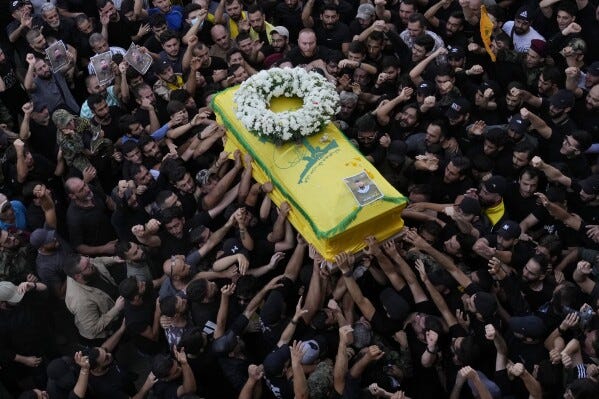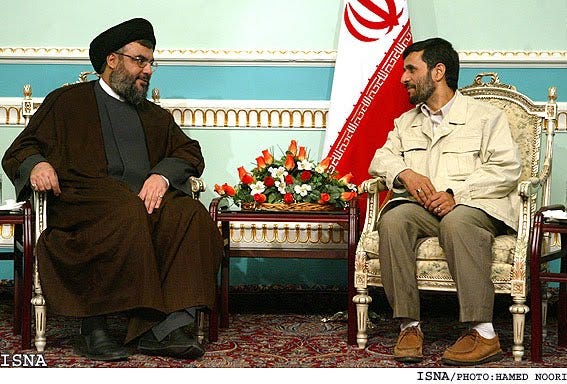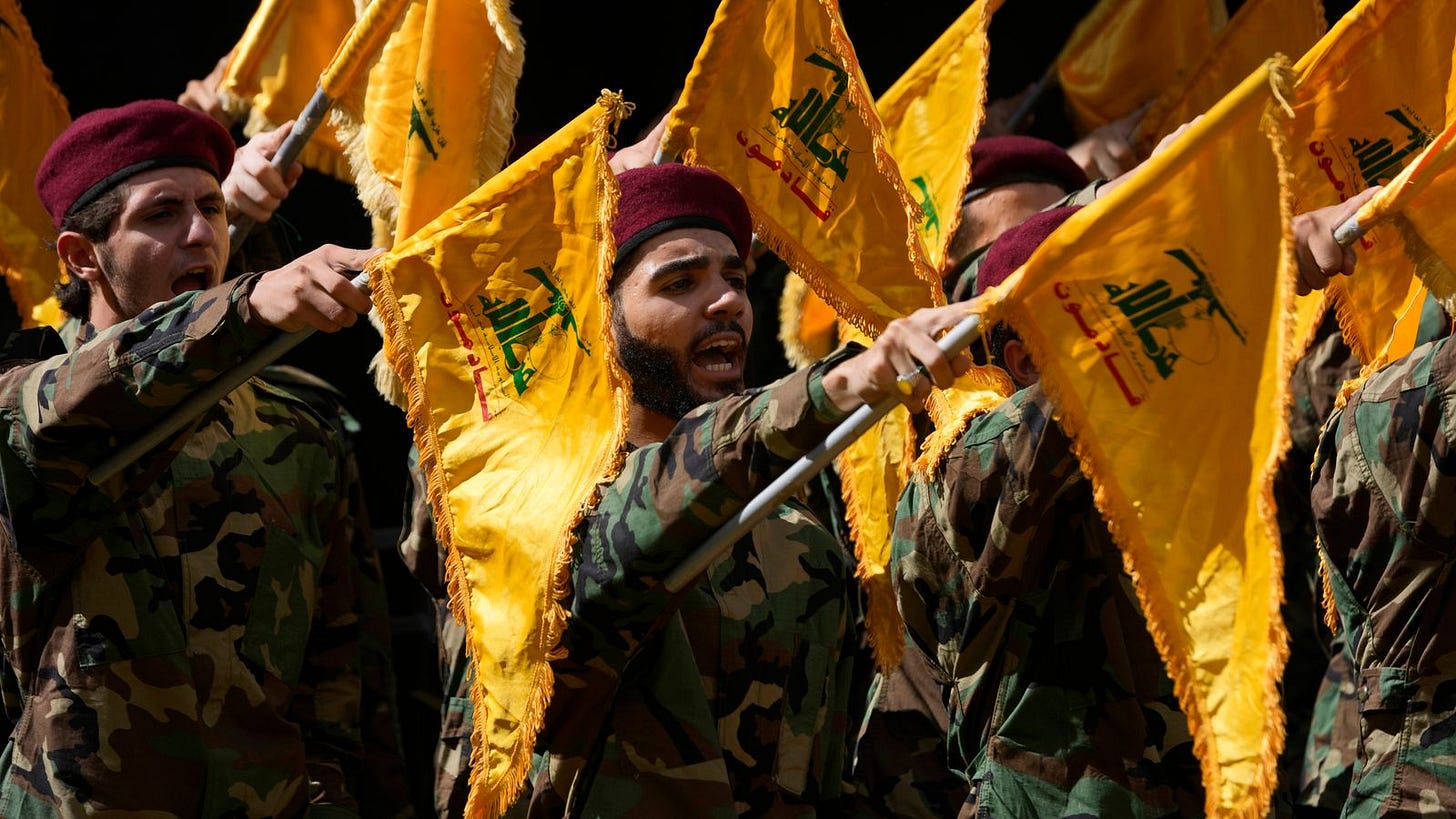Last Tuesday’s audacious Israeli attack on the IRGC’s Lebanon-based component, Hizbullah, where 4,000 pagers secretly laced with explosives were detonated across the country just after 3:30pm, has produced a predictable response in the West.
With precision, where one stands on the wider conflict tends to indicate one’s position on last week’s operation. Those already opposed to Israel’s war on Iran’s “Axis of Resistance” following the brutal massacre of 7th October—whether due to an existing opposition to the Jewish state or as a result of the emotional attrition of seeing the innocent civilian death toll rise during the IDF’s Gazan incursion—have been shocked by the attacks. They have accused Israel of behaving irresponsibly; operating outside the laws or ideals of a just war; and even performing, themselves, an act of terrorism. Make no mistake, while the latter claim is evidently fatuous, not all who put this forward are simply devoid of critical faculties. In many cases their objections say more about themselves than anything else. For all who spend their time shilling for the Islamic Revolution and denigrating any Israeli attempt to defend itself or win a war that it did not start, the operation last week posed a significant challenge. Did they ramp up the absurdity of their attacks on Israel, or did they bring themselves to accept that arguably the most successful large-scale targeted counter-terrorism operation the world has ever seen was just carried out by the Jews?
Hizbullah’s leadership has, for several years, been pushing for the adoption of low-tech forms of communication as a counter-intelligence measure. Israel’s long-standing success with high-tech espionage (and even assassination) forced a move down the technology ladder, and pagers were one such solution in which they invested early on. In February 2024 Hizbullah’s secretary-general, Hassan Nasrallah, went public with this plan, pleading with the organisation’s members to avoid using their phones, stating:
“Israel no longer needs collaborators […] Its surveillance devices are in your pockets. If you are looking for the Israeli agent, look at the phone in your hands and those of your wives and children.”
Pagers were by no means a new method of communication within the organisation, but their use expanded as intended.
While Nasrallah thought this would give his IRGC terrorists the edge they needed to stay ahead of the Israeli defence apparatus, it was in fact two steps ahead of them. Anticipating this ramp-up in Hizbullah’s pager usage the Israelis set up a front company, BAC Consulting, which was ostensibly based in Hungary and has, for the last three years, been licensed to produce pagers under the Gold Apollo brand, a leading producer and exporter of pagers based in Taiwan. Alongside fulfilling legitimate orders and manufacturing ordinary pagers for customers, the company separately produced specialised pagers containing explosive-laced batteries. And these were for devices ordered by Hizbullah.
This is the most impressive part of the entire episode. That Israel was able to so deeply penetrate Hizbullah’s supply chain, as far as taking on the production of the devices themselves, was truly an inordinate objective success. It is not only a lesson in the “dark arts” from one of the world’s most effective intelligence agencies, but it also ensured that the operation was, by definition, a targeted one. The explosive-laden pagers were, from the outset, destined only for Hizbullah members or collaborators. If one’s pager was not directly from Hizbullah’s supply network, it did not explode—a point rather lost on those gormlessly decrying Israel as indiscriminate in their methods. One can watch the videos for oneself of Lebanese citizens stood next to Hizbullah members as their pagers exploded, only to walk away unharmed.
The following day, a further 1,000 communications devices exploded in a similar attack on Hizbullah’s members, this time those using explosive-laden handheld radios. We have less information about the methods used to infiltrate the radio supply line, but the supposed manufacturer’s claims that the models used by Hizbullah had been discontinued for a decade, the batteries inside it had similarly ceased production, and the counterfeit-proofing holographic seal they would have attached to devices was missing from those in Hizbullah’s possession suggests that these, again, may have been controlled by Israeli intelligence from the point of production.
Official numbers suggest that 12 people died in Tuesday’s mass pager detonation, and 20 on Wednesday’s handheld radio attack. Furthermore, more than 3,000 combined are recorded as having been injured. Both Israeli and Western intelligence sources agree that this official number is a large understatement, and it is believed that between 300–400 Hizbullah members were killed at a minimum. These include four of Hassan Nasrallah’s personal staff. Saudi intelligence’s leaks of internal Hizbullah communications suggest the death toll is more than double that number and includes around 200 IRGC members in Iran and Yemen. We know that Iran’s ambassador to Lebanon was among those injured by the pager detonations, as though the uniformity of the IRGC, whether in Tehran or Beirut, needed underlining any further. Hizbullah’s special operations elites, the al-Haj Radwan Force, was likely hit very hard by the two attacks. An airstrike in southern Beirut killing the head of the force, Ibrahim Aqil, along with 10 other senior Hizbullah commanders further saw to this.
The success is not only a numbers game, as much as this entire conflict so often gets reduced to exactly that, although the large number of IRGC terrorists slain is undoubtedly good news. But the operation will have provided Israel with an enormous opportunity to map the extent and contours of the IRGC network in Lebanon. Media coverage, social media, communications, and hospital records provide Israeli intelligence with an extraordinary chance to map the organisation’s supply networks. Hizbullah’s attempts to solve for any future attack of this nature will further slow them down and weaken their attempt to gain any advantage as the tensions on Israel’s Northern border grow increasingly taut.
At a time where international rifts between Israel and her allies in the West are unfortunately growing, the operations last week will set Israeli intelligence in better standing with its Western siblings. Hizbullah has, historically, been a particular obstacle for Western intelligence, not least the CIA whose station chief in Lebanon, William Buckley, was kidnapped by Hizbullah in March 1984, tortured for more than a year, and finally murdered in June 1985. Indeed, if Israel exacting symbolic retribution was not enough, the US had actively placed a bounty on Ibrahim Aqil’s head for his role in organising the bombing of the US Embassy in April 1983 and suicide attacks on the US Marine Corps barracks in Beirut six months later. Good will from the West aside, the operations provide the Israeli intelligence services with a necessary bolstering of their image. Part of the success of Israeli intelligence relies on its perceived strength, which on its own merit is able to deter attacks and scare off enemy recruitment. No-one can deny that the operations last week were powerful projection of strength.
If Israel stepping up their response to the IRGC’s Lebanese army has come as a surprise to anyone, they haven’t been paying attention. When the Iranian Revolutionary Guard Corps’ Joint Operations Chamber ordered HAMAS and PIJ to execute their attack on Israel from Gaza last October, there was no doubt that this was accompanied by orders for other IRGC terrorists to join in the barrage against the Jewish State. Ansar Allah’s campaign of international piracy is perhaps the best example, but Hizbullah were likewise activated. Starting on 8th October, not 24 hours after HAMAS/PIJ’s butchering commenced, Hizbullah began to bombard Israel from the North. Over the last year, more than 9,000 missiles have since thundered over Israel’s Northern border.
There were fears back in October that this rocket fire, and the discovery of further IRGC tunnels from Lebanon into Israel, indicated a build-up to another similar 7th October-style attack coming from the North. Many in the war cabinet, including Defence Minister Yoav Gallant, were keen to preemptively strike Hizbullah from the outset. Blows have continued to be traded between Hizbullah and Israel over the Lebanese border, on which Hizbullah continue to maintain a military presence in direct contravention of UNSCR 1701. In the weeks leading up to Israel’s attack on Tuesday, Shin Bet thwarted a Hizbullah attempt to assassinate former IDF Chief of Staff, Aviv Kochavi. Clear as can be, the IRGC’s Lebanese contingent is an actor in this conflict, and always has been. There are still in excess of 70,000 Israelis displaced from their homes in the North of Israel, and several infiltration attempts from Lebanon have been seen off by the Israeli Defensive Forces. In the last week, Israel has added the safe return of these Israelis to the list of war aims.
It remains to be seen how the situation will develop—it is likely that Hizbullah/the IRGC will follow through on its threats to respond to Israel’s operation. The severity and impact of that response will undoubtedly set the scene for the months ahead. Israel is certainly preparing for the worst. All we know for sure is that last week’s operation reset the balance of fear heavily in favour of Jerusalem. For Hizbullah have sown the wind, and they shall reap the whirlwind.




